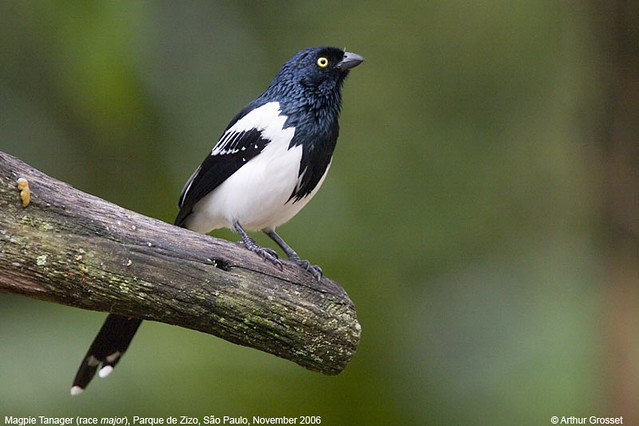Cissopis leverianus Cladus: Eukaryota Name Cissopis leverianus (Gmelin, 1788) Vernacular names
Syst. Nat. 1 pt1 p.302 The Magpie Tanager (Cissopis leveriana) is a South American species of tanager. It is the only member of the monotypic genus Cissopis. As suggested by its common name, this blue-black and white species is superficially reminiscent of a European Magpie. With a total length of 25-30 cm (10-12 in), a large percentage of which is tail, it is the longest species of tanager. It weighs 69-76 g. It is widespread in humid tropical and subtropical woodland, plantations, second growth, and parks in South America east of the Andes. It is absent from drier regions (e.g. the Caatinga) and most of north-eastern Brazil. In densely forested regions, it mainly occurs in relatively open sections (e.g. near major rivers). In such regions it is spreading with deforestation, which opens up the habitat. It is largely restricted to lowlands, but occurs up to an altitude of 2000 m (6500 ft) on the east Andean slopes. It is common throughout most of its range, but rarer in the Guianas. Typically occurs in conspicuous, noisy pairs or groups of up to 10 individuals. Commonly takes part in mixed-species flocks. Often moves long tail up and down. Eats seed, fruits and insects. The cup-shaped nest is lined with grass, leaves or other plant materials and is located low in trees near the ground or in shrubs in dense vegetation. The 2 eggs are reddish-brown with brown spots. The incubation time is 12-13 days in captivity. The binomial name commemorates the English collector Sir Ashton Lever. Restall, R., Rodner, C., & Lentino, M. (2006). Birds of Northern South America. Vol. 1 & 2. Helm, London. ISBN 0-7136-7242-0 (vol. 1); ISBN 0-7136-7243-9 (vol. 2). Source: Wikipedia, Wikispecies: All text is available under the terms of the GNU Free Documentation License |
|

